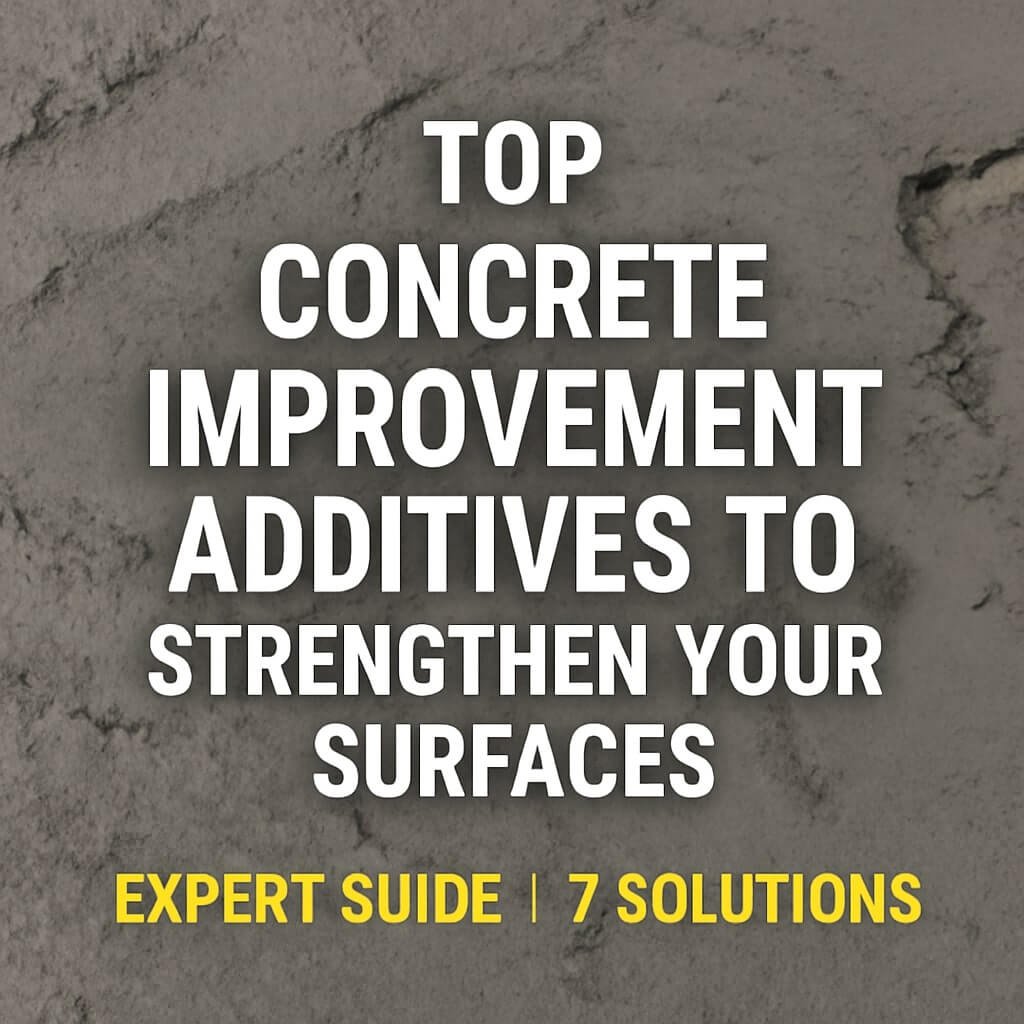Concrete is the backbone of modern infrastructure. From roads and bridges to homes and skyscrapers, concrete plays a critical role. But not all concrete is created equal. The right additives can dramatically enhance its strength, flexibility, and longevity. Concrete improvement additives are specialised compounds mixed with concrete to alter its properties in desirable ways. Whether you’re a contractor or a DIY enthusiast, understanding how these additives work is essential for ensuring long-lasting, high-performance surfaces.
Why Strengthening Concrete Matters
Durability and reliability are non-negotiable when it comes to concrete. Stronger concrete translates into fewer cracks, less maintenance, and improved safety over time. Whether you’re pouring a foundation or crafting a driveway, using additives to improve concrete strength helps it resist:
- Weathering from rain, snow, and UV rays
- Mechanical stress from heavy loads or traffic
- Chemical damage from salts and other corrosive agents
Incorporating strength-enhancing additives isn’t just about extending lifespan—it’s also about ensuring structural integrity from day one.
Types of Concrete Additives
Concrete additives can be categorized based on their function. Some accelerate curing, while others improve workability or increase resistance to freezing and thawing. Below are seven top-performing additives that professionals rely on to improve concrete strength and performance.
1. Water-Reducing Additives
Water-reducing additives decrease the water-cement ratio without sacrificing workability. Less water means denser, stronger concrete with better durability. These additives:
- Improve compressive strength
- Enhance surface finish
- Reduce permeability
Ideal for slabs, bridges, and high-performance construction projects.
2. Accelerating Additives
Accelerators speed up the setting time of concrete. This is crucial in cold weather or when fast turnaround is needed. They:
- Enable quicker finishing
- Reduce curing time
- Lower labor costs
Common accelerators include calcium chloride and non-chloride compounds, especially suitable for winter pours.
3. Retarding Additives
In hot climates or large-scale projects, retarding additives are used to slow the setting time of concrete. This helps avoid premature hardening and allows for:
- Extended workability
- Better surface finish
- Improved joint strength
They’re especially useful in large pours like highways or industrial floors.
4. Air-Entraining Additives
Air-entraining agents introduce microscopic air bubbles into the concrete mix. These bubbles improve freeze-thaw resistance and reduce scaling. Benefits include:
- Enhanced durability in cold climates
- Reduced cracking
- Better resistance to deicing chemicals
Essential for pavements, curbs, and outdoor surfaces exposed to freezing weather.
5. Superplasticizers
Superplasticizers, or high-range water reducers, dramatically increase concrete fluidity without additional water. Their benefits include:
- Improved workability for complex forms
- High-strength concrete with low water content
- Better surface finish
Widely used in precast concrete, bridges, and high-rise buildings.
6. Corrosion-Inhibiting Additives
Steel reinforcement in concrete is prone to corrosion, especially in marine or road environments. Corrosion-inhibiting additives protect rebar by:
- Reducing chloride penetration
- Enhancing bond strength
- Prolonging structural life
They’re often used in parking decks, tunnels, and coastal structures.
7. Shrinkage-Reducing Additives
Drying shrinkage can cause cracking and surface defects. Shrinkage-reducing additives minimize this risk by:
- Controlling internal stress
- Reducing curling and cracking
- Improving surface appearance
Ideal for floors, overlays, and high-performance slabs where aesthetics and function matter.
How to Choose the Right Additive for Your Project
Choosing the right additive depends on your project’s specific needs. Consider factors like:
- Climate and weather conditions
- Type of structure
- Desired strength and durability
- Budget and availability
Always consult product data sheets and, if needed, speak with a structural engineer to ensure compatibility and performance.
Application Methods for Additives
Additives are typically mixed with concrete during batching. Here are common application methods:
- Pre-Mixed – Additive is mixed at the concrete plant.
- On-Site Mixing – Additive is added to the mixer truck before or during transit.
- Post-Additive Application – Some additives are surface-applied, especially hardeners or sealants.
Always follow the manufacturer’s instructions for best results.
Additive Dosage: Getting It Right
Proper dosing is critical. Overdosing can weaken the concrete or cause delayed setting, while underdosing may render the additive ineffective. Tips:
- Use calibrated equipment
- Follow dosage guidelines on the product label
- Test small batches if uncertain
If in doubt, conduct a trial mix or consult the supplier.
Common Mistakes to Avoid When Using Additives
Avoid these frequent errors:
- Mixing incompatible additives
- Ignoring environmental conditions
- Improper sequencing of additive mixing
- Using expired products
Proper planning and execution are key to realizing the full benefits of concrete additives.
FAQs About Concrete Additives
1. Are concrete additives necessary for every project?
Not always. Additives are used to enhance performance for specific conditions like cold weather, structural load, or aesthetic requirements.
2. Can multiple additives be used together?
Yes, but compatibility must be tested. Some additives may react poorly with others, reducing effectiveness.
3. Do additives affect curing time?
Yes. Accelerators speed it up, while retarders slow it down. Choose based on your climate and schedule.
4. Will additives increase the cost of concrete?
Slightly, but the long-term savings from durability and reduced repairs often outweigh the initial cost.
5. Are these additives environmentally friendly?
Many modern additives are formulated to be low-impact. Always check the manufacturer’s environmental data.
6. Do I need professional help to use additives?
Not necessarily. With proper research and manufacturer guidelines, even DIY users can apply additives successfully.
Conclusion: Stronger Surfaces, Smarter Solutions
Concrete additives are not just optional upgrades—they’re strategic tools that enhance performance, extend lifespan, and optimize construction. Whether you’re pouring a patio or constructing a skyscraper, choosing the right additive makes a measurable difference. Understanding the function, application, and benefits of each type ensures you’re building surfaces that last, perform, and impress.









